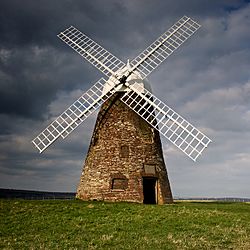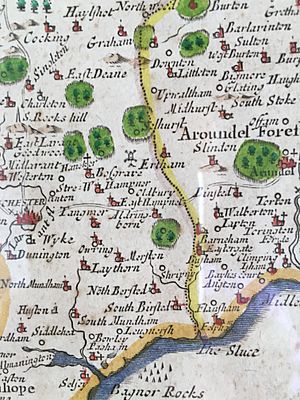Halnaker Windmill facts for kids
Quick facts for kids Halnaker Windmill |
|
|---|---|
 |
|
| Origin | |
| Mill name | Halnaker Mill |
| Grid reference | SU 920 097 |
| Coordinates | 50°52′44″N 0°41′38″W / 50.879°N 0.694°W |
| Operator(s) | West Sussex County Council |
| Year built | Mid-18th century |
| Information | |
| Purpose | Corn mill |
| Type | Tower mill |
| Storeys | Four storeys |
| No. of sails | Four sails |
| Type of sails | Common sails |
| Windshaft | Cast iron (post restoration addition) |
| Winding | Fantail (missing) |
| No. of pairs of millstones | Two pairs |
Halnaker Windmill is a tall tower mill located on Halnaker Hill. This hill is found northeast of Chichester, in Sussex, England. You can reach the mill by following a public path. This path starts from the north end of Halnaker village. It follows an old road called Stane Street before turning towards the hilltop.
The mill's brick tower no longer has any machinery inside. It used to offer shelter, but it doesn't anymore. However, a short distance away, there is a strongpoint from World War II. This old structure can still protect you from the wind and rain.
Contents
History of Halnaker Windmill
Halnaker Mill was first mentioned way back in 1540. At that time, it was part of the "Halfnaked" manor. The mill was built for the Duke of Richmond. It served as the main mill for the Goodwood Estate.
The mill you see today is believed to have been built around the 1740s. We know it was standing by about 1780. Halnaker Mill worked for many years. But in 1905, lightning struck it. This strike damaged its sails and the main shaft.
The damaged mill was fixed up in 1934 by a company called Neve's. They were millwrights from Heathfield. This repair was done to remember the wife of Sir William Bird. More repairs happened in 1954 by E Hole and Sons. They were also millwrights, from Burgess Hill. The mill was restored again in 2004. Today, West Sussex County Council owns Halnaker Mill.
What Halnaker Windmill Looks Like
Halnaker Mill is a tower mill with four floors. It has a special cap on top that looks like a beehive. This cap has sixteen sides. The mill was first designed to be turned by hand. Later, it got a fantail. This part would automatically turn the mill into the wind. However, the fantail was not put back during later restorations.
The mill has four large common sails. These sails were originally attached to a wooden shaft. This wooden shaft was damaged by the lightning strike in 1905. A new shaft made of cast iron was then installed. This new shaft came from another mill. It was too short for Halnaker Mill. So, the repair company added a spacer to make it fit. The mill used to grind grain with two pairs of millstones. These stones were "overdrift," meaning they were turned from above.
Who Worked at the Mill?
Many people worked as millers at Halnaker Mill over the years. Here are some of them:
- John Hervey (around 1810)
- Charles Adams (from 1839 to 1870)
- G R Watkins (from 1868 to 1905)
A Poem About the Mill
Halnaker Mill is famous because of a poem written about it. The English writer Hilaire Belloc wrote this poem. He called it "Ha'nacker Mill," which is how people really say the name. In the poem, the mill falling apart is a way to talk about bigger ideas. It shows how old ways of life and society can change or break down.
Ha'nacker Mill
SALLY is gone that was so kindly,
Sally is gone from Ha'nacker Hill
And the Briar grows ever since then so blindly;
And ever since then the clapper is still...
And the sweeps have fallen from Ha'nacker Mill.
Ha'nacker Hill is in Desolation:
Ruin a-top and a field unploughed.
And Spirits that call on a fallen nation,
Spirits that loved her calling aloud,
Spirits abroad in a windy cloud.
Spirits that call and no one answers --
Ha'nacker's down and England's done.
Wind and Thistle for pipe and dancers,
And never a ploughman under the Sun:
Never a ploughman. Never a one.
This poem has also been turned into songs. Composers like Peter Warlock and Ivor Gurney have created musical versions of "Ha'nacker Mill."


